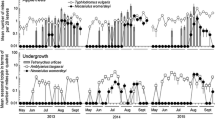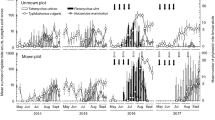Abstract
To improve the success of integrated pest management (IPM) in apple orchards, we investigated whether generalist phytoseiid mites have suppressed the occurrence of Tetranychus urticae. In Akita Prefecture, northern Japan, in 2012 and 2013, two types of experimental plot were compared. Conservation plots had been managed for the conservation of generalist phytoseiid mites by selective chemical spraying without mowing since 2009. Conventional plots were managed by non-selective chemical spraying with regular mowing. The conservation plots had significantly fewer T. urticae adult females per tree in both years. Two species of generalist phytoseiid mites—Typhlodromus vulgaris and Amblyseius tsugawai—were continuously present in the conservation plots, with only a few T. urticae. The conservation plots had significantly more A. tsugawai adult females in the undergrowth in both years, and significantly more T. vulgaris adult females on apple leaves in 2012. Typhlodromus vulgaris was continuously present in the conservation plots but was scarce from late May to early August in the conventional plots. In the presence of T. vulgaris, low numbers of T. urticae did not increase on apple leaves. These results indicate that the generalist phytoseiid mites serve as important biological control agents in IPM in apple orchards.




Similar content being viewed by others
References
Amalin D, Pena MJE, Yu SJ, McSorley R (2000) Selective toxicity of some pesticides to Hibana velox (Araneae: Anyphaenidae), a predator of citrus leafminer. Fla Entomol 83:254–262
Amano H, Ishii Y, Kobori Y (2004) Pesticide susceptibility of two dominant phytoseiid mites, Neoseiulus californicus and N. womersleyi, in conventional Japanese fruit orchards (Gamasina: Phytoseiidae). J Acarol Soc Jpn 13:65–70
Coombes TG, Sotherton NW (1986) The dispersal and distribution of polyphagous predatory Coleoptera in cereals. Ann Appl Biol 108:461–474
Croft BA, Shearer P, Fields GJ, Riedl HW (1990) Distribution of Metaseius occidentalis (Nesbitt) and Typhlodromus pyri Scheuten (Parasitiformes: Phytoseiidae) in apple orchards of the Hood River Valley, Oregon. Can Entomol 122:5–14
Duso C, Pasqualetto C (1993) Factors affecting the potential of phytoseiid mites (Acari: Phytoseiidae) as biocontrol agents in North-Italian vineyards. Exp Appl Acarol 17:241–258
Funayama K (2010) Occurrence of pyrethroid-resistant individuals of the indigenous predatory mite, Neoseiulus womersleyi (Schicha) (Acari: Phytoseiidae), in apple orchards of Akita Prefecture in northern Japan. Jpn J Appl Entomol Zool 54:208–211 (in Japanese with English summary)
Funayama K (2014) Unmown groundcover conserves adult populations of the predatory ground beetle Chlaenius micans (Coleoptera: Carabidae) in commercial apple orchards. Appl Entomol Zool 49:183–187
Funayama K, Sonoda S (2014) Plantago asiatica ground cover supports Amblyseius tsugawai (Acari: Phytoseiidae) populations in apple orchards. Appl Entomol Zool. doi:10.1007/s13355-013-0222-2
Goto T (1997) Annual life cycles of population of the two-spotted spider mite, Tetranychus urticae Koch (Acari: Tetranychidae) in four Japanese pear orchards. Appl Entomol Zool 32:207–216
Hamamura T, Shinoda T (2003) Influence of agricultural chemicals against the phytoseiid mites. http://www.naro.affrc.go.jp/project/results/laboratory/vegetea/2003/vegetea3-14.html (in Japanese)
Hassan SA (1994) Activities of the IOBC/WRPS Working Group on pesticide and beneficial organisms. In: Pesticides and Beneficial Organisms (H. Vogt ed.). Bull IOBC/WRPS 17: 1–5
Ishikawa T (2011) Akinori Kimura’s miracle apples (Presented by Ono Y). URL http://www.imaginepeace.com/miracleapples/
Kawasaki T, Yano S, Osakabe MH (2009) Effects of wall structure and light intensity on the settlement of a predatory mite, Euseius sojaensis (Ehara) (Acari: Phytoseiidae). Appl Entomol Zool 44:81–84
Kawashima M, Amano H (2006) Overwintering phenology of a predacious mite, Typhlodromus vulgaris (Acari: Phytoseiidae), on Japanese pear trees, observed with Phyto traps. Exp Appl Acarol 39:105–114
Kim D, Lee J (2003) Oviposition model of overwintered adult Tetranychus urticae (Acari: Tetranychidae) and mite phenology on the ground cover in apple orchards. Exp Appl Acarol 31:191–208
Kishimoto H (2002) Species composition and seasonal occurrence of spider mites (Acari: Tetranychidae) and their predators in Japanese pear orchards with different agrochemical spraying programs. Appl Entomol Zool 37:603–615
Kishimoto H (2005) A new technique for efficient rearing of phytoseiid mites (Acari: Phytoseiidae). Appl Entomol Zool 40:77–81
Kunimoto Y, Nakama T, Amano H, Takafuji A (2009) Species composition of predators of spider mites in persimmon orchards in Nara prefecture with reference to the effect of weed management. J Acarol Soc Jpn 18:7–16 (in Japanese with English summary)
Markó V, Keresztes B, Fountain MT, Cross JV (2009) Prey availability, pesticides and the abundance of orchard spider communities. Biol Control 48:115–124
McMurtry JA, Croft BA (1997) Life-styles of phytoseiid mites and their roles in biological control. Annu Rev Entomol 42:291–321
McMurtry JA, Huffaker CB, van de Vrie M (1970) Ecology of tetranychid mites and their natural enemies: a review I. Tetranychid enemies: their biological characters and the impact of spray practices. Hilgardia 40:331–390
McMurtry JA, Demoraes GJ, Sourassou NF (2013) Revision of the lifestyles of phytoseiid mites (Acari: Phytoseiidae) and implications for biological control strategies. Syst Appl Acarol 18:297–320
Mochizuki M (2003) Effectiveness and pesticide susceptibility of the pyrethroid-resistant predatory mite Amblyseius womersleyi in the integrated pest management of tea pests. Biocontrol 48:207–221
Niemelä J, Spence JR, Spence DH (1992) Habitat associations and seasonal activity of ground-beetles (Coleoptera, Carabidae) in central Alberta. Can Entomol 124:521–540
Ohtsuka K, Osakabe MH (2009) Deleterious effects of UV-B radiation on herbivorous spider mites: they can avoid it by remaining on lower leaf surfaces. Environ Entomol 38:920–929
Onzo A, Hanna R, Zannou I, Sabelis MW, Yaninek JS (2003) Dynamics of refuge use: diurnal, vertical migration by predatory and herbivorous mites within cassava plants. Oikos 101:59–69
Perkár S (1999) Effect of IPM practices and conventional spraying on spider population dynamics in an apple orchard. Agric Ecosyst Environ 73:155–166
Rodriguez JG (1958) The comparative NPK nutrition of Panonychus ulmi (Koch) and Tetranychus telarius (L.) on apple trees. J Econ Entomol 51:369–373
SAS Institute (2008) JMP version 8.02. SAS Institute, Inc., Cary, NC, USA
Sekita N (1985) Toxicity of pesticides commonly used in Japanese apple orchards to the predatory mite Typhlodromus pyri Scheuten (Akari: Phytoseiidae) from New Zealand. Appl Entomol Zool 21:173–176
Sonoda S, Izumi Y, Kohara Y, Koshiyama Y, Yoshida H (2011) Effect of pesticide practice on insect biodiversity in peach orchards. Appl Entomol Zool 46:335–342
Sonoda S, Yamashita J, Koshiyama Y, Kohara Y, Enomoto T (2013) Short-term effects of mowing on insect communities in Japanese peach orchards. Appl Entomol Zool 48:65–72
SSRI (2012) Excel Statistics 2012. SSRI Co., Ltd
Toyoshima S (2003) A candidate of predatory phytoseiid mites (Acari: Phytoseiidae) for the control of the European red spider mites, Panonychus ulmi (Koch), (Acari: Tetranychidae) in Japanese apple orchards. Appl Entomol Zool 38:387–391
Toyoshima S, Amano H (2006) Diversity and abundance of phytoseiid mites on Magnolia hypoleuca Siebold et Zuccarini, a candidate source of natural enemies in natural vegetation. Appl Entomol Zool 41:349–355
Toyoshima S, Ihara F, Amano H (2008) Diversity and abundance of phytoseiid mites in natural vegetation in the vicinity of apple orchards in Japan. Appl Entomol Zool 43: 443–450
Toyoshima S, Yaginuma K, Ihara F, Arai T, Takanashi M (2011) The succession of phytophagous and phytoseiid species in a newly planted apple orchard without insecticide application. J Acarol Soc Jpn 20:77–86
Toyoshima S, Kishimoto H, Amano H (2013) Phytoseiid mite portal. http://phytoseiidae.acarology-japan.org/ (in Japanese)
Uesugi R, Goka K, Osakabe MH (2002) Genetic basis of resistances to chlorfenapyr and etoxazole in the two-spotted spider mite (Acari: Tetranychidae). J Econ Entomol 95:1267–1274
Yano S (2008) Collective and solitary behaviors of the two-spotted spider mite (Acari: Tetranychidae) are induced by trail following. Ann Entomol Soc Am 101:247–252
Yano S, Osakabe M (2009) Do spider mite-infested plants and spider mite trails attract predatory mites? Ecol Res 24:1173–1178
Acknowledgments
We thank A. Oda, A. Sato, and K. Kagaya of the Akita Fruit Tree Experiment Station for their assistance with the field work. This research was financially supported by the Ministry of Agriculture, Forestry and Fisheries, Japan, through a research project entitled “Development of technologies for mitigation and adaptation to climate change in agriculture, forestry and fisheries” and by the joint research program implemented at the Institute of Plant Science and Resources, Okayama University, Japan.
Author information
Authors and Affiliations
Corresponding author
Rights and permissions
About this article
Cite this article
Funayama, K., Komatus, M., Sonoda, S. et al. Management of apple orchards to conserve generalist phytoseiid mites suppresses two-spotted spider mite, Tetranychus urticae (Acari: Tetranychidae). Exp Appl Acarol 65, 43–54 (2015). https://doi.org/10.1007/s10493-014-9850-7
Received:
Accepted:
Published:
Issue Date:
DOI: https://doi.org/10.1007/s10493-014-9850-7




